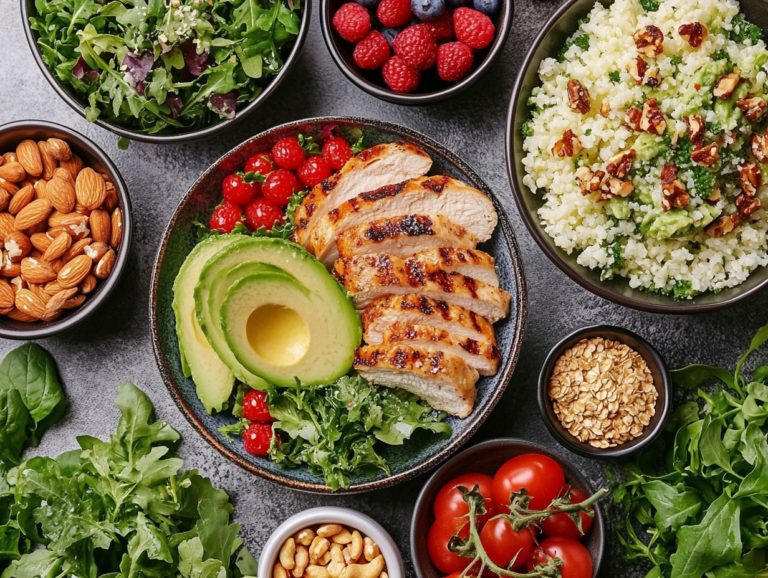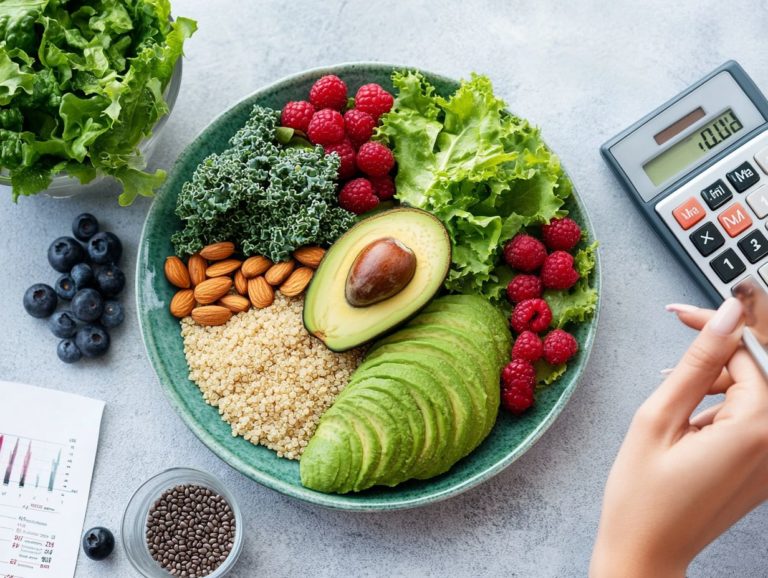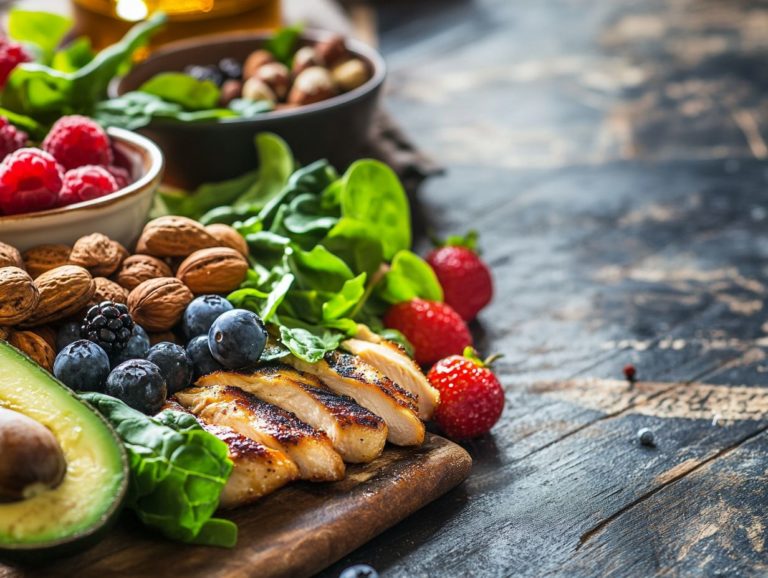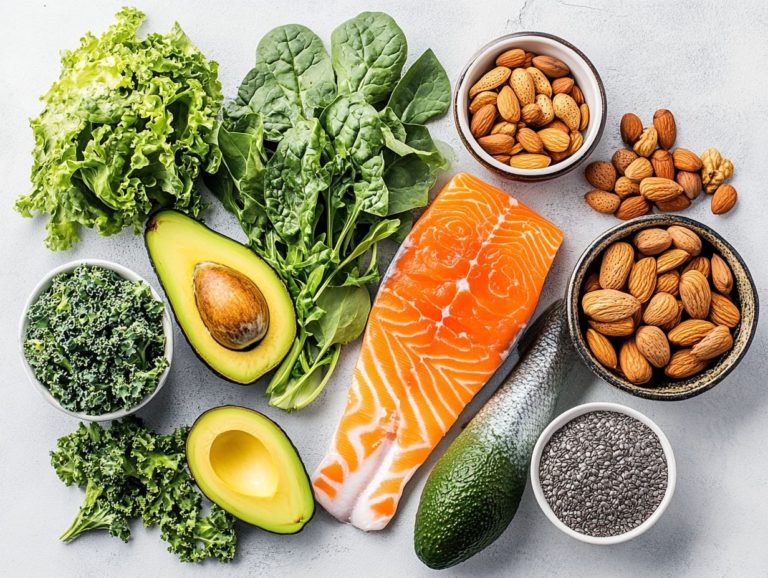Keto Diet: Understanding Nutritional Labels
The keto diet has taken the health and wellness scene by storm, captivating followers with its enticing promise of weight loss, weight maintenance, and elevated energy levels.
To fully embrace its benefits, you must grasp the intricacies of nutritional labels and food labels. This article delves into the essentials of the keto diet, exploring its mechanics, nutrition facts, and the advantages it provides.
You will discover how to interpret nutritional labels with precision, dismantle prevalent misconceptions, and leverage this knowledge to refine your meal planning and food choices. Immerse yourself in the world of the keto diet and elevate your health journey!
Contents
- Key Takeaways:
- What Is the Keto Diet?
- How Does the Keto Diet Work?
- What Are the Benefits of the Keto Diet?
- What Are the Nutritional Labels?
- What Information is Included on Nutritional Labels?
- How to Read Nutritional Labels on Keto?
- 1. Check the Serving Size
- What Are Some Common Misconceptions About Nutritional Labels on Keto?
- Protein is Unlimited on Keto
- How to Use Nutritional Labels to Plan Meals on Keto?
- Calculate Net Carbs
- 3. Make Adjustments Based on Personal Goals and Needs
- Frequently Asked Questions
- What is the Keto Diet and why is understanding nutritional labels important?
- How do I determine if a food is suitable for the Keto Diet by reading its nutritional label?
- What pitfalls should you avoid when reading nutritional labels for the Keto Diet?
- Are there any specific ingredients or nutrients I should be looking for on nutritional labels when following the Keto Diet?
- How often should I check nutritional labels while on the Keto Diet?
- Can I enjoy packaged or processed foods on the Keto Diet?
Key Takeaways:
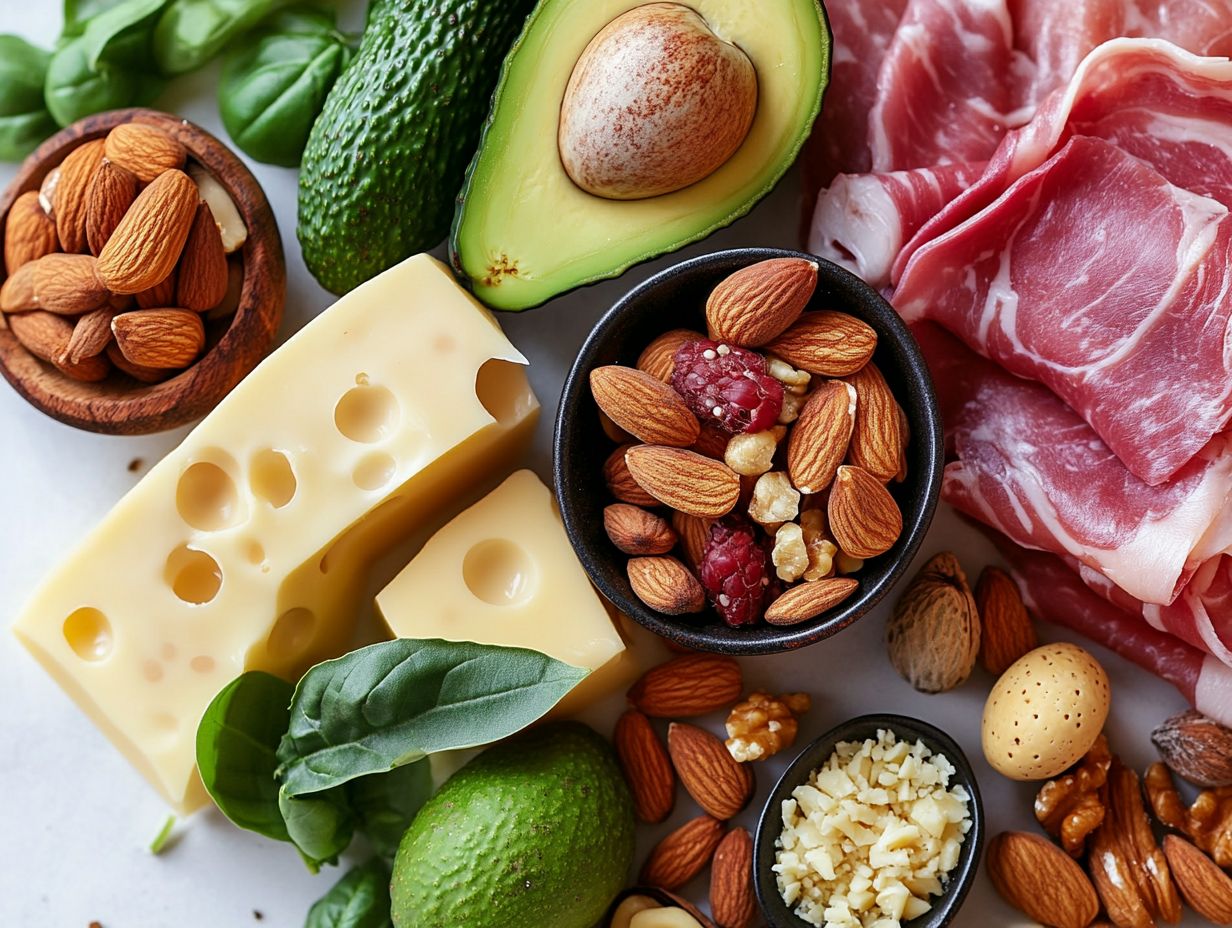
- The Keto Diet is low in carbs and high in fats, promoting ketosis.
- Focus on serving size, total carbs, fiber, and fat when reading labels.
- Use nutritional labels to calculate net carbs and balance fat and protein intake.
What Is the Keto Diet?
The keto diet is a low-carb, high-fat approach that has garnered significant attention among those who prioritize health and seek effective solutions for weight loss and maintenance.
By greatly reducing your carbohydrate intake and replacing it with fats, you can prompt your body to enter a state of ketosis, which is when your body burns fat for energy instead of carbs. This transformation not only encourages a balanced macronutrient profile that supports optimal energy levels but also helps you avoid hidden sugars, added sugars, and processed foods.
As you embark on this keto journey, you ll likely find yourself more attuned to nutritional information, including total carbohydrates and net carbs, which are crucial for successfully maintaining this distinctive eating pattern.
How Does the Keto Diet Work?
The keto diet revolves around dramatically cutting carbohydrate intake, which triggers a process where your body burns fat for energy instead of carbs. In this state, your body becomes exceptionally adept at converting fats into energy. The liver steps up, breaking down fatty acids and creating ketones, which serve as an alternative energy source. This state is achieved by keeping a close eye on nutritional labeling.
This transformation changes how your body uses energy and nutrients. By keeping an eye on your net carbs and including dietary fiber, you can skillfully manage your caloric intake, ensuring you stay within the crucial macronutrient ratios that support your journey in maintaining ketosis.
What Are the Benefits of the Keto Diet?
The keto diet presents a myriad of benefits that go far beyond just shedding pounds; it impacts multiple facets of health and wellness. By embracing a low-carb, high-fat lifestyle, you may find yourself enjoying heightened energy levels, sharper mental clarity, and a healthier fat profile that aligns perfectly with your health aspirations. This is partly due to managing daily values and energy density effectively.
As your body shifts into ketosis, it becomes a pro at burning stored fat while curbing those pesky cravings for processed foods and hidden sugars, encouraging a more balanced approach to nutrition. This thoughtful macronutrient balance not only aids in weight maintenance but also nurtures healthier food choices in your daily life.
What Are the Nutritional Labels?
Nutritional labels, required by the FDA under the Nutrition Labeling and Education Act, offer crucial insights into the foods you consume, enabling you to make informed choices about your diet. These labels are designed to reflect consumer demand for transparency in food quality and ingredient lists.
Typically found on grocery store products, these labels present essential nutrition facts, such as serving size, calorie content, and a comprehensive breakdown of macronutrients, including total carbohydrates, fats, proteins, grams of protein, grams of fat, grams of sugar, and sugars. This helps in monitoring food quality and making better food choices.
By mastering the art of reading these labels, you can skillfully navigate food packaging and ingredient lists, allowing you to pinpoint unhealthy options that may be hiding excessive sugars or artificial preservatives.
What Information is Included on Nutritional Labels?
Nutritional labels offer a detailed glimpse into a food product s nutritional profile. They equip you with essential information to truly understand what you re consuming. Key elements include the serving size, which indicates how much of the product is recommended for consumption. It also includes total carbohydrates, which encompass added sugars and dietary fiber.
The label outlines the grams of protein, fats, and sugars. This enables you to evaluate the food’s nutrient balance in relation to your dietary preferences, especially if you’re following a low-carb or keto-friendly lifestyle.
Understanding the ingredient list is also important. It helps you identify natural and artificial sweeteners present in the food.
If you’re on a keto diet, knowing the total carbohydrates listed is crucial. It directly impacts ketosis, the metabolic state you re striving for with this approach. Added sugars can significantly raise your carbohydrate intake, potentially causing unwanted spikes in blood sugar levels. In contrast, dietary fiber plays a key role in digestive health and managing hunger.
By diligently reading nutritional labels, you can make informed choices that align with your health objectives. This ensures that each food item enhances your overall dietary strategy while managing carbohydrates per serving and being cautious of misleading health claims.
How to Read Nutritional Labels on Keto?
Effectively reading nutritional labels is essential for anyone on the keto diet. It empowers you to make informed choices about your food and maintain your desired net carb intake. Additionally, understanding complex carbs is important as they impact your dietary goals.
Begin by checking the serving size. This will help you grasp how many portions you re consuming and whether you’re staying within your carbohydrate limits.
Next, scrutinize the total carbohydrates listed. This serves as the foundation for calculating net carbs, which is crucial for maintaining ketosis. Be attentive to the sugar content and watch out for hidden sugars or carbohydrates that might not be immediately apparent.
1. Check the Serving Size
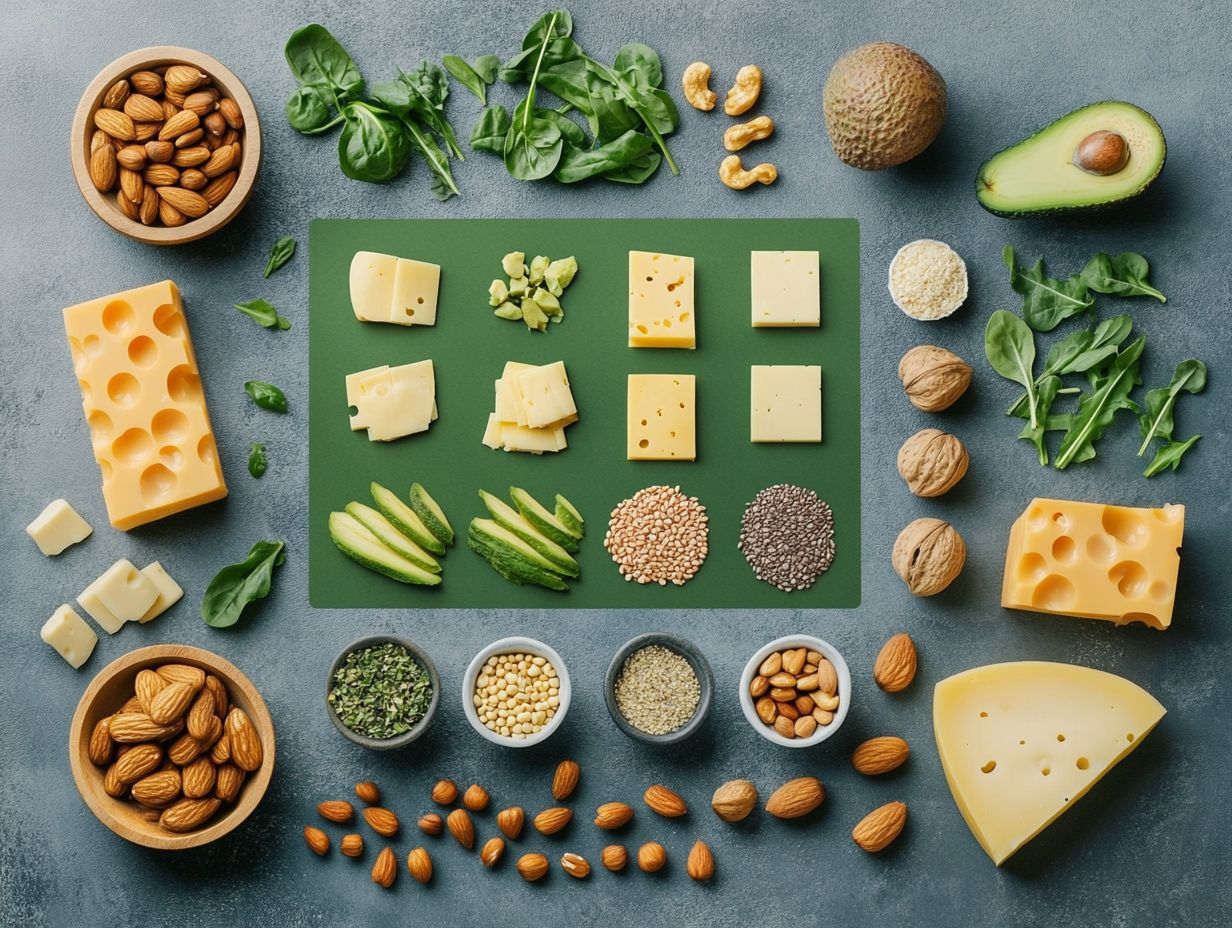
The first step in mastering nutritional labels is to examine the serving size. This detail is the cornerstone for understanding the overall nutritional content of the food. The serving size reveals the quantity upon which the nutritional information is based. This is crucial for those on a keto diet, where even minor adjustments in portion size can dramatically affect your carbohydrate consumption and adherence to low-carb principles.
By grasping the significance of serving sizes, you can manage your dietary choices with greater precision. For example, a common serving of nuts may appear modest at one ounce, but it can harbor a notable amount of carbs if you indulge beyond that limit.
While a single avocado may be low in carbs, consuming multiple servings could lead to a rapid increase in your total carbohydrate intake. Therefore, maintaining an awareness of standard serving sizes for foods like cheese, heavy cream, or low-carb tortillas can significantly benefit you if you re committed to a ketogenic lifestyle.
This mindfulness ensures you remain within your daily carb limits while enjoying a delightful variety of foods at your disposal, including keto-friendly options like E.V.O.O. Lemon Herb Dressing, Green & Black s 85% Cacao Bar, and Salazon s Dark Chocolate.
Make informed choices today to enhance your dietary journey!
In this guide, we will explore essential tips for managing your carbohydrate intake while following a keto diet. Understanding how to read nutritional labels on keto foods will help you make informed food choices that align with your dietary goals.
2. Look at the Total Carbohydrates
Next, it s essential for you to examine the total carbohydrates listed on the nutrition facts label, as this figure is foundational for anyone following a keto diet. Total carbohydrates encompass all types of carbs in the food, including sugars, starches, and fiber.
To find out the net carbs, subtract fiber and certain types of sugars, such as sugar alcohols, from the total carbohydrates. This calculation gives you a clearer picture of what will affect your state of ketosis.
Understanding this distinction can significantly impact your meal planning, as various foods can have dramatically different carbohydrate contents. For instance, a cup of cooked broccoli contains about 6 grams of total carbohydrates, with approximately 2.4 grams of fiber. This results in around 3.6 net carbs, making it an excellent choice for your keto journey.
In contrast, processed foods like an average chocolate bar can contain a lot of added sugars, which poses a challenge for maintaining ketosis. On the flip side, an average serving of quinoa can pack about 39 grams of total carbohydrates, presenting a greater challenge for maintaining ketosis.
This variance highlights the importance of carefully reading nutritional labels and considering how different foods can fit into your low-carb daily allowance. Be cautious with processed meats and artificial preservatives, which can add unexpected carbohydrates to your diet.
3. Consider the Fiber Content
When you analyze nutritional labels, pay close attention to the fiber content, as it plays a pivotal role in calculating net carbs, which is essential for the keto diet. Dietary fiber, often included in the total carbohydrates, isn’t digested by your body and doesn t spike your blood sugar levels.
This means that when you’re calculating net carbs, you should subtract fiber from the total carbohydrates. Understanding sugar names on labels can also help you avoid added sugars. This approach enables you to enjoy fiber-rich foods while staying true to your low-carb guidelines.
Incorporating dietary fiber into your keto-friendly meal plan can significantly enhance your digestive health and promote feelings of fullness, making it easier to maintain ketosis. Foods like avocado, chia seeds, and leafy greens are fantastic sources of fiber that effortlessly fit into your ketogenic lifestyle.
By embracing these fiber-rich options, you not only optimize your nutrient intake but also create a more balanced and varied diet that supports weight maintenance and overall health. For instance, adding chia seeds to your smoothies or salads can dramatically increase the fiber content without jeopardizing your carbohydrate limits, allowing you to indulge while remaining steadfast in your dietary goals.
4. Pay Attention to the Sugar Content on Food Labels
Paying close attention to the sugar content listed on nutritional labels is vital for anyone adhering to the keto diet since excessive sugar intake can hinder your efforts to maintain ketosis. This section of the label typically highlights added sugars, which are sugars incorporated into the food product during processing or preparation.
Understanding grams of sugar per serving size can help you stay within your daily carbohydrate limits. Being mindful of hidden carbohydrates that may not be immediately apparent allows you to make healthier food choices and avoid products that could derail your low-carb diet.
This includes recognizing hidden sugars and understanding the energy density of foods. For those following a keto lifestyle, recognizing added sugars is crucial, as they can significantly impact your daily carbohydrate limits.
To effectively identify these lurking sugars, keep an eye out for ingredients like high fructose corn syrup, cane sugar, or any word ending in ‘-ose’ on labels these often signal hidden sugars. Food packaging and nutritional labeling can sometimes be misleading, so it’s crucial to scrutinize the ingredient list.
Even seemingly healthy foods, such as fruit yogurts, salad dressings, and certain sauces, can harbor substantial amounts of added sugars that can easily sabotage your dietary goals. By reading labels diligently, you can better manage your sugar intake and foster a sustainable, low-carb regimen that promotes overall health. Opt for natural sweeteners as alternatives to reduce grams of sugar and total carbohydrates.
By following these tips and being mindful of your food choices, you can enhance your ketogenic lifestyle and achieve your dietary goals.
5. Check for Hidden Carbohydrates
It’s crucial to scrutinize nutritional labels for hidden carbohydrates. Many processed foods contain ingredients that can artificially inflate carb counts.
These sneaky carbs often hide in everyday staples like ketchup, barbecue sauce, and salad dressings. Sugars are frequently added to enhance flavor. You might be surprised to discover that even seemingly healthy options like yogurt and granola can be loaded with unexpected carbs.
Some processed foods also include artificial sweeteners or sugar alcohols that can affect your carb count. By paying close attention to ingredient lists and specifically searching for terms like maltodextrin, corn syrup, and various types of starch, you can navigate your diet more effectively.
This diligence helps you avoid unwanted carbohydrates and empowers you to make more informed and healthful food choices.
6. Look at the Fat Content
Understanding the fat content on nutritional labels is essential as you navigate the keto diet. It directly impacts the type of fats you eat necessary for achieving ketosis.
The label usually indicates the grams of fat per serving, broken down into saturated, unsaturated, and trans fats. This gives you valuable insight into the quality of fats you consume.
By opting for healthy fat sources, you can align your dietary choices with the core principles of the keto diet. Healthy fats such as those found in avocados and olive oil can help maintain energy density while supporting your dietary goals.
Being aware of these fats empowers you to thrive in your low-carb lifestyle. Healthy fats, found in avocados, olive oil, and nuts, help you meet your necessary fat intake and support essential metabolic processes.
These beneficial fats assist in nutrient absorption, hormone production, and can even enhance your mental clarity. When consumed in appropriate portions, they positively contribute to your macronutrient balance. Always consider the serving size to ensure you are consuming fats in appropriate proportions.
7. Consider the Protein Content
Considering the protein content on nutritional labels is essential for anyone following the keto diet. Protein plays a crucial role in maintaining muscle mass and promoting overall health.
The grams of protein per serving serve as your guide to achieving an optimal macronutrient balance. This ensures you consume enough protein to support your activity level without exceeding your carbohydrate limits.
Selecting high-quality protein sources such as lean meats, eggs, and low-carb dairy products can significantly elevate the nutritional value of your meals. You can strategically incorporate these proteins by pairing them with healthy fats like avocado or olive oil, which are critical in the keto lifestyle.
When planning your meals, aim for a harmonious balance of protein and fats while keeping carbohydrates minimal. By mastering the art of reading nutritional labels, you can effortlessly make informed decisions to optimize your protein intake and maintain ketosis.
What Are Some Common Misconceptions About Nutritional Labels on Keto?
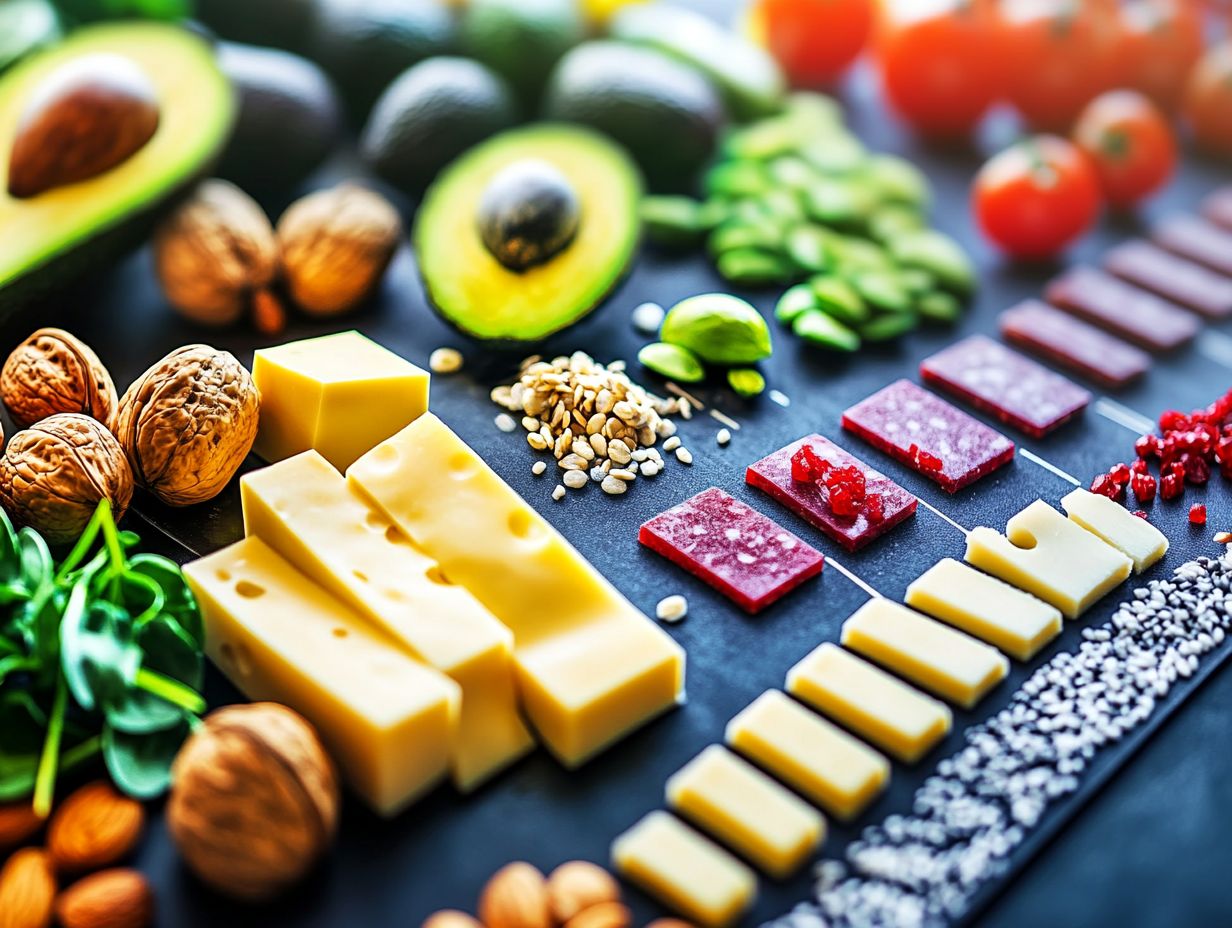
Even with the growing popularity of the keto diet, misconceptions surrounding nutritional labels can lead to confusion and misinformation as you navigate this dietary approach.
One prevalent misunderstanding is the notion that all carbohydrates are inherently harmful. This fails to recognize the vital role of dietary fiber and the difference between complex carbohydrates and simple sugars. This misconception often overlooks the benefits of net carbs in maintaining a balanced diet.
Many people mistakenly think that all high-fat foods are beneficial on keto. This overlooks the necessity of evaluating the overall quality and composition of the fats you consume.
1. All Carbohydrates are Bad
One of the most widespread misconceptions about the keto diet is the belief that all carbohydrates are the enemy and should be shunned at all costs. This oversimplification ignores the nuanced role carbohydrates play in nutrition and fails to distinguish between complex carbs, which offer essential nutrients and fiber, and simple sugars that can contribute to weight gain and various health problems.
In truth, understanding the different types of carbohydrates and prioritizing the quality of your food choices is vital for maintaining a balanced diet.
Opting for complex carbohydrates and sources of dietary fiber can significantly enhance your overall health. It can improve digestion, regulate blood sugar levels, and promote that coveted feeling of fullness.
Even if you’re following a keto lifestyle, there are still plenty of fiber-rich options at your fingertips. Explore options like leafy greens, avocados, and nuts today! These options not only support your health but also maintain an optimal macronutrient balance. They provide energy units for daily activities.
Incorporating these fiber sources can help alleviate some common digestive issues that may arise from dramatically cutting back on carbohydrates. This ultimately fosters a more sustainable approach to healthy eating. Always check the nutrition facts label to ensure you are getting the most out of your food choices.
2. High-Fat Foods are Always Good on Keto
One common misconception you might encounter is the belief that all high-fat foods are beneficial on the keto diet. This can lead you to overlook the importance of evaluating the health benefits of the fats you consume.
While healthy fats are essential for a successful keto journey, not all fats are created equal. Processed foods laden with unhealthy trans fats can negatively affect your health and compromise the principles of healthy eating.
It s crucial to prioritize good fat sources like avocados, nuts, and olive oil to achieve an optimal fat profile. By making informed choices about your fat sources, you not only support your metabolic processes but also enhance your overall well-being.
Healthy fats, such as those found in fatty fish like salmon, seeds, and grass-fed meats, are rich in essential omega-3 fatty acids, which are good for your heart and help reduce inflammation.
Always consider the calories and grams of fat per serving size when selecting your fats. Conversely, saturating your diet with fats from processed meats or pastries can lead to health issues like cardiovascular disease if consumed excessively.
Incorporating a variety of wholesome fat sources into your meals will help maintain a balanced diet, ensuring your body receives the nutrients it needs to thrive on this low-carb journey. Be cautious of artificial preservatives in processed foods that can negatively impact your health.
Protein is Unlimited on Keto
A common misconception is the belief that protein consumption on the keto diet is limitless. This can lead to unintended consequences, such as exceeding your daily calorie limits or disrupting your state of ketosis.
While protein is indeed an essential macronutrient that plays a crucial role in muscle maintenance, it’s vital to understand the importance of macronutrient balance. Always check the grams of protein, carbohydrates, and fats to ensure you’re within your dietary limits.
Overindulging in protein can quickly derail your progress, as it can lead to gluconeogenesis, the process where your body converts excess protein into glucose, potentially hindering your body s ability to maintain ketosis. Knowing your recommended daily protein intake is essential. Learn how to effectively incorporate it into your meals for a successful keto lifestyle. Food manufacturers often include detailed nutritional information to help you make better food choices.
To achieve the desired state of ketosis, aim for a higher percentage of fats, moderate protein, and very low carbohydrates in your diet. Monitoring your protein intake is crucial; aim for protein to make up about 15-25% of your total caloric intake. Focus on high-quality sources, such as grass-fed meats, fish, and eggs.
Striking the right balance among these macronutrients not only supports sustained energy levels but also helps prevent challenges like weight stalls, ensuring that your body efficiently utilizes fat for fuel instead of relying too heavily on protein for energy.
How to Use Nutritional Labels to Plan Meals on Keto?
Effectively utilizing nutritional labels is essential for planning your meals on the keto diet. This practice enables you to monitor your net carb intake and stay within your desired macronutrient ratios.
By grasping the nutritional information on these labels, you empower yourself to make informed food choices that align with your dietary goals while also minimizing the risks of hidden carbohydrates and excessive sugars.
By prioritizing macro ratios that highlight healthy fats and appropriate protein levels, you transform meal planning into a strategic approach, ensuring the sustainability of your successful low-carb lifestyle.
Calculate Net Carbs
Calculating net carbs is essential for you if you’re committed to the keto diet, as it plays a pivotal role in maintaining ketosis. To determine your net carbs, simply subtract dietary fiber and certain sugar alcohols from the total carbohydrates listed on the nutritional label. This straightforward calculation gives you a clearer understanding of the carbohydrates that could affect your blood sugar levels and ketosis, enabling you to make better meal choices within a low-carb framework.
Embrace this method with all your meals for incredible results! For example, if you encounter a food item with 20 grams of total carbohydrates, 10 grams of dietary fiber, and 2 grams of erythritol (a popular sugar alcohol), you would calculate the net carbs like this: 20 minus 10 minus 2, resulting in a mere 8 grams of net carbs.
It s vital to apply this method across various foods because items such as vegetables and nuts differ in fiber content, which can significantly influence the net carb total. By recognizing how net carbs function, you can stay within your carb limits, supporting your overall keto success and boosting your energy levels.
2. Determine Fat and Protein Ratio
Determining the right fat and protein ratio is crucial for optimizing the benefits of the keto diet, as it directly influences your dietary results and overall health. A typical keto diet should include a higher fat intake often around 70-75% of your total daily calories while protein usually constitutes about 20-25%.
Careful analysis of nutritional labels and considering the balance of fats, proteins, and carbs can help you craft meals that align perfectly with your dietary goals. For more guidance, check out how to read food labels on keto to help you maintain a state of ketosis.
Accurate calculation and adjustment of these ratios require consideration of personal factors like your activity level, medical issues, and weight management objectives. If you re athletic, a higher protein intake may be advantageous for muscle recovery, while you might prefer healthy fats from sources like avocados and olive oil to enhance your sense of fullness.
Exploring a variety of food options, such as nuts, seeds, and fatty fish, allows you to enjoy a delightful mix of flavors and textures, ensuring your meals remain satisfying. Get creative and experiment with new recipes that excite your palate while helping you hit your macronutrient targets without feeling deprived.
3. Make Adjustments Based on Personal Goals and Needs
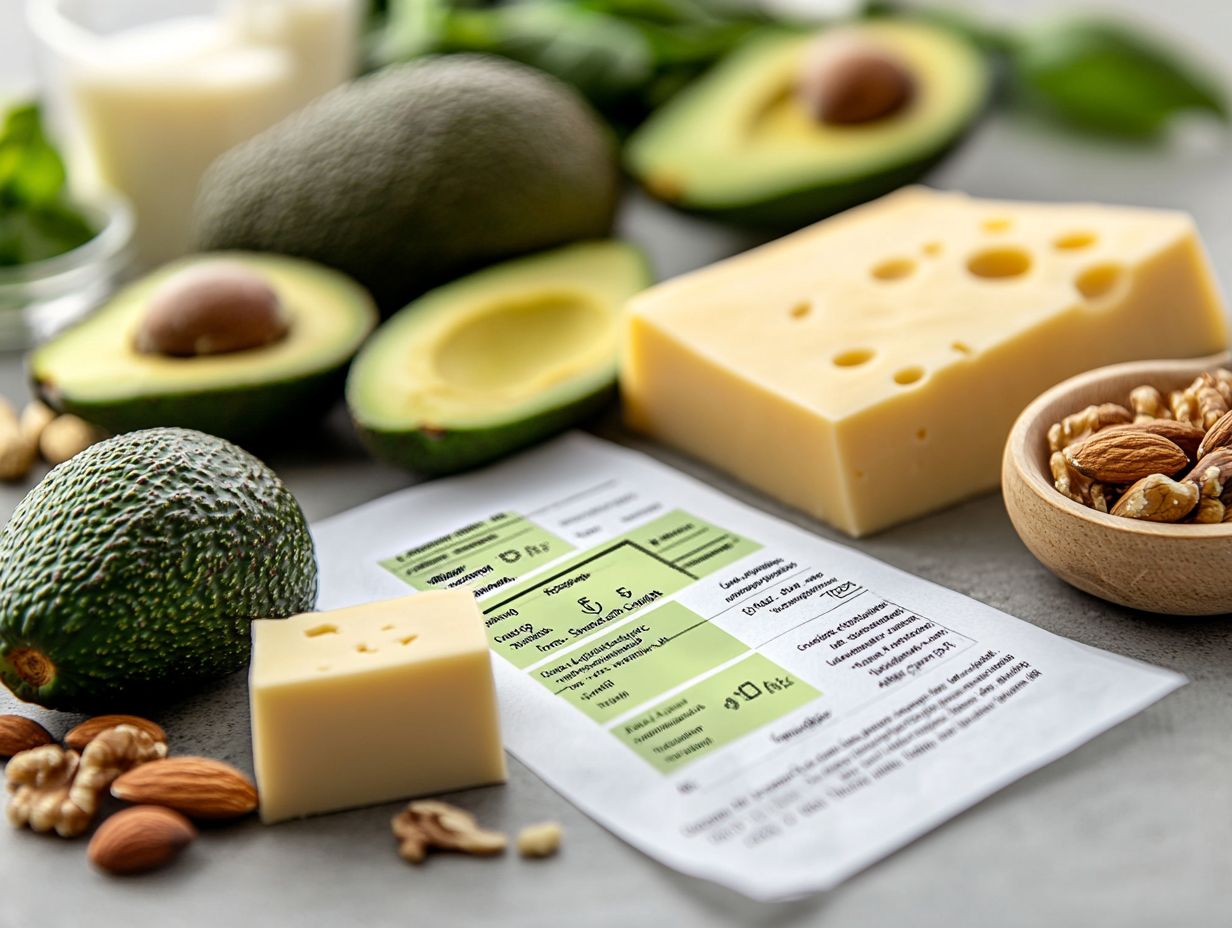
Making necessary adjustments based on your personal goals and dietary needs is crucial for achieving long-term success on the keto diet, as your body and lifestyle are uniquely yours. By evaluating nutritional labels and understanding how different foods align with or hinder your objectives be it weight loss, energy levels, or specific health conditions you can customize your meal plans to fit your needs.
This personalized approach not only helps you stick to the keto diet but also enhances your overall satisfaction and well-being. Paying close attention to serving sizes and the macronutrient composition fats, proteins, and carbohydrates can significantly influence your journey.
For instance, choosing healthier fat sources like avocados or olive oil over processed oils can provide better nutritional benefits. Incorporating low-carb vegetables can boost your nutrient intake while keeping those crucial ketosis levels intact.
Keeping a food diary to track your meal choices and how they align with your goals is incredibly beneficial, fostering a mindful approach to eating. By making small, incremental changes and celebrating your victories along the way, you can cultivate a balanced, keto-friendly lifestyle that promotes both health and enjoyment.
Frequently Asked Questions
What is the Keto Diet and why is understanding nutritional labels important?
The Keto Diet is a high-fat, moderate protein, and very low-carb diet designed to promote weight loss and improve overall health. Understanding nutritional labels is crucial for success on this diet as it helps ensure you are consuming the right balance of macronutrients to stay in a state of ketosis.
How do I determine if a food is suitable for the Keto Diet by reading its nutritional label?
First, look at the total carbohydrate count and subtract the grams of fiber and sugar alcohols to calculate the net carbs. Ideally, net carbs should be less than 50g per day for most individuals on the Keto Diet. Next, check the fat and protein content to ensure they are in line with the recommended ratios for this diet.
What pitfalls should you avoid when reading nutritional labels for the Keto Diet?
Some common pitfalls include not paying attention to serving sizes, not accounting for hidden carbs (such as those in sauces or dressings), and not considering the source of fat (some fats, like trans fats, should be avoided on the Keto Diet).
Are there any specific ingredients or nutrients I should be looking for on nutritional labels when following the Keto Diet?
Yes, some important ingredients to look for include healthy fats like avocado, coconut oil, and olive oil, as well as high-quality sources of protein such as grass-fed beef and wild-caught fish. It’s also important to choose foods with minimal added sugars or artificial sweeteners.
Armed with this knowledge, you’re ready to tackle the keto diet confidently. Happy dieting!
How often should I check nutritional labels while on the Keto Diet?
Check nutritional labels regularly, especially when trying new foods or recipes.
Continue tracking your macros throughout the day to stay within the Keto guidelines.
Can I enjoy packaged or processed foods on the Keto Diet?
You can enjoy packaged foods just make sure to check the labels closely!
Ensure they fit your daily macronutrient goals and are made with quality ingredients.


